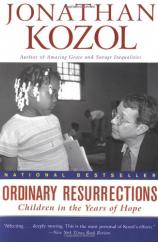Ordinary Resurrections: Children in the Years of Hope
Review
Ordinary Resurrections: Children in the Years of Hope
Perhaps there is no other social institution in this country that calls our attention to the disparities between the races as education. Jonathan Kozol, the National Book Award-winning author of many books, including the National Book Critics Circle Award finalist and best-selling SAVAGE INEQUALITIES, has elected to return to that milieu in order to check up on the kids he interviewed for that book. ORDINARY RESURRECTIONS: Children in the Years of Hope takes a hard look at four years in the lives of South Bronx students and how their games and learning expressed a national desire to keep the walls of racism in place.
It is a hard pill to swallow. Yes, inferior education exists in the United States, one of the planet's richest countries. Yes, these children are at a disadvantage because money is scarce in their communities and the way they are taught and where they are taught reflects that. Although the teachers Kozol encounters seem bright and willing, and the children themselves, in endless recountings of their gentle conversations, sound prepossessed of an ability to find happiness in their situations that most Prozac-chomping Americans would find enviable, Kozol asks us to feel sorry for these children. In actuality, we should be celebrating their presumptions that they are okay, that they don't always notice that they are not surrounded by trees and birds but by drug dealers and cement. Is that not a fitting tribute to the glory of God, as Thomas Merton would say (the philosopher whom Kozol quotes in the beginning of the book), that these children make the best of what they have and that the "hope" in the title refers to what lives in their hearts now and will surely make their lives better in the future?
As an indictment of a weak system, ORDINARY RESURRECTIONS does its job. When it pities its subjects, it is a lesser work and damning to the very stirring portraits of the children that Kozol lays down in print. Basically, what he finds is that children are children, naturally equipped with imaginations and hearts that know no boundaries for love. With those two things intact and nurtured by even the oldest, most strict nun (St. Ann's is one of the schools Kozol has chosen to examine), do they not have the ability to soar? Kozol should stop feeling sorry for them and start celebrating their resilience, bravery, and thirst for knowledge --- it would make the book a great deal more enjoyable and worthy of his subjects.
Reviewed by Jana Siciliano on February 20, 2001
Ordinary Resurrections: Children in the Years of Hope
- Publication Date: February 20, 2001
- Genres: Nonfiction
- Paperback: 400 pages
- Publisher: Harper Perennial
- ISBN-10: 0060956453
- ISBN-13: 9780060956455



